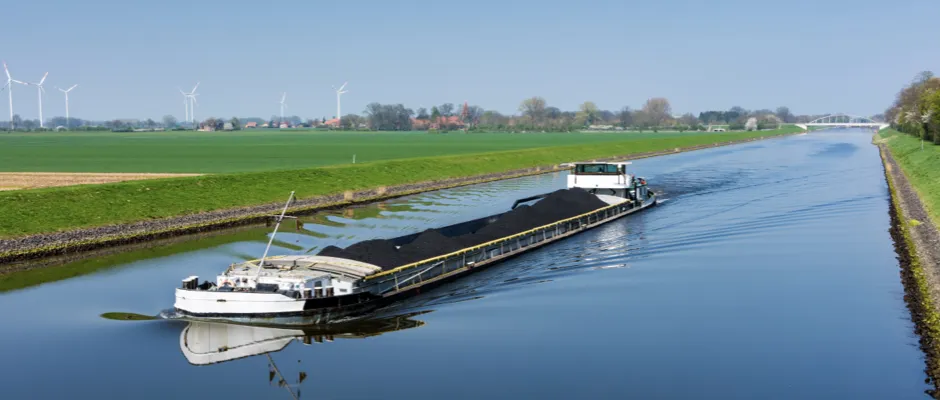HVO in Inland Shipping: Sustainable Drop-In Fuel for an Almost Emission-Free Fleet
Author: Jeroen Berger • Publication date:
Inland shipping is a strategic pillar of European freight transport, yet it faces increasing pressure due to tightening environmental regulations. By 2050, the sector must operate nearly emission-free, as stipulated in the Paris Climate Agreement, embedded in the European Green Deal, and legally codified in the European Climate Law (EU 2021/1119). At the same time, the inland fleet primarily consists of existing vessels built for decades-long use. Investments in zero emission technologies such as batteries or hydrogen require new infrastructure, new vessels, and a fundamental systems transition, something that is not feasible for many shipowners and shipping companies in the short term. Within this context, Hydrotreated Vegetable Oil (HVO) provides an immediate route to substantial emission reductions without the need to modify engines or bunkering infrastructure. HVO thus represents a realistic transitional solution toward climate-neutral inland shipping.
This article examines the technical functioning of HVO, its practical environmental benefits, compatibility with existing engines, the policy and market landscape, logistical challenges, and its positioning relative to other sustainable fuels.
What is HVO and How Does It Work as a Marine Fuel?
HVO, also referred to as “blue diesel,” is a synthetic diesel produced by hydrogenating biogenic residual streams such as used cooking oil, animal fats, or tall oil. The hydrogenation process yields pure paraffinic hydrocarbons that are chemically nearly identical to conventional diesel.
This chemical similarity makes HVO a so-called drop-in fuel: it can be used in existing diesel engines without any technical modifications. The pure variant (HVO100) consists entirely of biogenic components, while blends such as HVO20 or HVO50 partially replace fossil diesel. In practice, compatibility is high, even with older engines, provided that certain rubber components (such as nitrile seals) are replaced in a timely manner.
Environmental Gains in Practice: Climate and Air Quality
HVO’s primary benefit lies in its drastic reduction of greenhouse gas emissions. When sustainably produced, HVO100 achieves a well-to-wheel CO2 reduction of approximately 90% compared to fossil diesel. Direct exhaust emissions, or tank-to-wheel emissions, are virtually zero, as the CO2 content in HVO is biogenic and therefore part of the short carbon cycle.
A second environmental benefit lies in its cleaner combustion. HVO contains no sulfur or aromatics and has a high cetane number (approximately 80–90), which leads to more complete combustion than standard diesel. As a result, emissions of soot (particulate matter) and nitrogen oxides (NOx) are significantly reduced. When used in combination with modern Stage V or Euro VI engines, local emission reductions of up to 99% are achievable. This improves air quality along waterways and in port areas, which is an increasingly important criterion in environmental zoning and permitting.
Onboard Technology and Performance: No Trade-Offs Required
HVO complies with the European fuel standard EN 15940 for paraffinic diesel and closely matches the specifications of EN 590 in nearly all respects. Its energy density per liter is slightly lower than that of fossil diesel (about 3%), but in practice, operators report no noticeable difference in fuel consumption or engine power. Some even report reduced stress on injectors and filters, due to HVO’s cleaner combustion and absence of aromatics.
Its high cetane number also ensures smooth ignition, resulting in quieter engine operation and a measurable noise reduction of up to 3 dB. HVO also has favorable storage properties: it does not oxidize, is resistant to microbial growth, and retains its stability over long storage periods. This overcomes a known drawback of traditional FAME biodiesel, which is prone to aging and microbial contamination.
Field tests have shown that even older engines operate reliably on HVO100. Pilot projects such as the vessel La Coruña (1,500 hours on HVO100) demonstrate that switching is possible without power loss or malfunctions. Only engines manufactured before 1990 may require the replacement of nitrile rubber seals with Viton, due to HVO’s lack of swelling aromatics.
Policy Framework and Market Dynamics: Opportunities and Constraints
An increasing number of EU Member States are paving the way for HVO use in inland shipping. In 2023, Germany recognized HVO100 as a permitted marine fuel, leading to accelerated adoption by market leaders such as HGK Shipping. Belgium is also actively promoting HVO as a lever within the Inland Shipping Green Deal. A study by the Institute for Inland Waterway Transport (ITB) estimated that up to 35% CO2 reduction is achievable by 2035, primarily through HVO use in combination with exhaust aftertreatment systems and more efficient engines.
In the Netherlands, HVO use in inland shipping is permitted but subject to different dynamics. Due to the excise exemption on red diesel (as stipulated in the Mannheim Convention), fossil gas oil is artificially inexpensive. This fiscal distortion hampers the scale-up of sustainable alternatives. However, in June 2025, the Dutch cabinet announced plans to review this exemption, which could improve HVO’s competitive position.
Meanwhile, the market is seeing a growing number of shippers willing to pay a premium for CO2 reductions. Initiatives such as GoodShipping link inland shipping capacity with sustainable fuels, with companies like Ikea and Heineken covering the price differential. At the same time, industry associations emphasize the need for targeted policy support, such as excise rebates, per liter subsidies, or differential port fees.
Logistical Availability and Scale-Up Potential
HVO is currently available only at a limited number of specialized bunkering locations, supplied by providers such as GoodFuels, Shell, or Finco Fuel. This raises practical concerns among shipowners and operators regarding refueling and route planning: consistent CO2 reduction requires reliable HVO access. HGK Shipping addresses this by bulk purchasing and maintaining internal logistic reserves.
Another constraint is the limited availability of sustainable feedstocks. Ideally, HVO is produced from waste fats and residual oils, but these sources are finite. Certification systems such as ISCC ensure traceability and prevent competition with the food chain. Nevertheless, HVO will not serve as a permanent solution but rather as a transitional fuel until alternatives such as hydrogen, methanol, or e-fuels become technically and economically mature.
Comparison with Alternative Fuels
Compared to other options such as GTL, FAME, LNG, or electric propulsion, HVO offers the most balanced combination of immediate applicability and substantial climate impact. GTL, a synthetic diesel derived from natural gas, delivers similar reductions in local emissions but remains a fossil fuel and thus does not contribute to long-term CO2 reduction.
FAME is biogenic and has been used in blends for some time, but it is structurally limited by oxidation sensitivity and increased risk of microbial contamination. LNG, in turn, requires major modifications to engines and fuel storage systems and is generally fossil-derived, unless explicitly produced as bio-LNG.
Zero-emission alternatives such as hydrogen or batteries are still in early stages of technical development. Their deployment remains limited to short-distance operations or specific newbuild projects.
HVO therefore stands out as the only immediately deployable fuel that can be used on a large scale in the existing fleet, yielding measurable climate benefits without requiring major technical investment.


